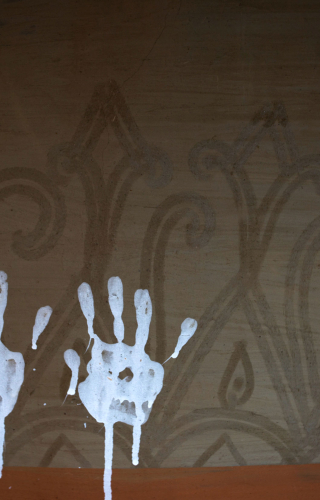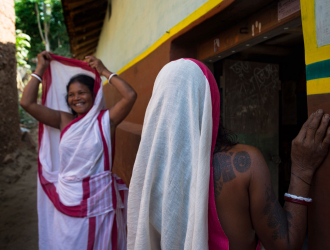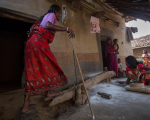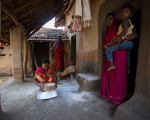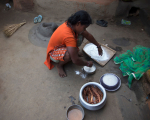I have always had a keen interest in painting, having dabbled with art since childhood. As I grew older, I was naturally curious to know about different art forms. Paintings always fascinated me, both to appreciate how they are made and to understand what they mean. As a photographer, I try to document art forms made in different contexts, especially during festivals. Through my photography, I came to know of villages in Purulia where new paintings are made during Bandna. Bandna is celebrated by agrarian communities bordering West Bengal and Jharkhand to mark a new harvest. Bandna is not fixed by date, and different communities celebrate it on different dates; this makes photographing Bandna a real challenge if you are not from the region.
Though largely observed in tribal areas, Bandna has many Hindu observances, practices and rituals, reflected in the veneration of symbols of fertility and prosperity. Bandna essentially celebrates the initiation of a new phase, not just through a new crop cycle, but metaphorically expressed in many tasks performed within each family. For example, each household makes new rangoli during Bandna. This task is carried out by females of all ages in the family, irrespective of their class status. The art form is simple. It is striking to observe their natural talent for making patterns, which are made spontaneously from memory. They don’t have any recorded history about the practice, and whatever they make, has been handed down from mother to daughter. One way they have passed the skill down generations is allowing children to make their own designs from an early age.
Bandna is an occasion for cattle veneration as well, having origins in Hindu mythology. It is believed Lord Shiva provided cattle to help humans in agriculture with a condition that they be treated well. In course of time humans broke the promise and cattle were ill-treated daily. Fed up, the cattle complained to Lord Shiva about their miserable condition. Lord Shiva planned a surprise visit during cover of Amabasya (Lunar phase of the New Moon) in the month of Kartik. However, news of the complaint leaked to villagers and before Lord Shiva arrived, everybody cleaned and decorated the cattle shed, bathed the cattle and fed them special food. On seeing the arrangements, Lord Shiva was satisfied and he returned, ignoring the allegations. Every year this cycle of complaints and Lord Shiva’s visit is celebrated during Bandna.
Because cattle is held sacred, women collect cow dung and apply a fresh coat on floors and walls. This way, a new canvas is made available each year. Next, they prepare the paint (chawk). I was lucky to witness the making of the white colour; this is done by mixing finely pounded rice powder and glue extracted from the Gamhar tree, which makes the solution viscous, allowing it to drip freely. No brush is used in the whole process; the only tool is gravity. The paintings are executed fast, almost in one seamless free-flowing motion, always starting from the house entrance. In the house I visited, they took less than 10 minutes to fill up every inch of a large courtyard. Earlier, minerals or plant-based extracts were used for making colour, which were limited to mostly earthy tones. To provide contrast, white or black (made from charcoal) was used. Colours were applied only on walls, not on floors. Painting of the walls involves different techniques. First, the wall is made wet, to ensure the paint is absorbed. Textures are added by carving into the wall with the use simple household tools. The iconography is also more elaborate than floor art, which consist mostly of geometric patterns or drawings of flora and fauna inspired from nature. In comparison, wall art may include complex narratives depicting religious themes and daily life.
However, making wall art is not the central event of Bandna, which takes place over a week, interspersed with many rituals and observances. Buying of new items for the household precedes the week-long events. The first day is called Jagran, when household cattle are taken for a bath in a nearby waterbody. In the evening lamps are lit around the cattle shed, in front of entrances and the tulsi manch (holy basil shrine). Freshly made pitha (rice cake) is eaten by the whole family. Music and dance is performed throughout the night to ward off evil spirits.
On the second day, called Gohal Puja, female family members purify the floors of the house, the tulsi manch and angan (courtyard) with cow dung solution in the morning. Only women take part in rituals because they are symbolically associated with fertility. The women observe a day-long fast. Early morning, they go to a nearby waterbody, carrying arwa chaal (rice) in a container where it is washed properly in water. After ablution, the women return to their home and dry the wet rice. It is then crushed using a dhenki (wooden rice mill). The rice powder is collected and strained through a sieve to collect the fine dust, later used to make paint. On the same day, puja is offered in the name of family ancestors at the tulsi manch. The women make palm impressions and apply sindoor tika (vermilion dot) on agricultural implements and the doorframe. Arwa chaal and dhup ghashare also sprinkled. This is the only time of the year when women are allowed to touch agricultural tools. Goth puja is performed outside the village, where a live chicken is sacrificed or an egg is broken. On the third day, called Barad Bhidka, bulls are tied to a pole. Here they are teased with a dry skin, accompanied by loud applause by the villagers and music.
On my way back to Kolkata, I was left thinking about the richness of Indian culture with so many rituals, arts and myths integrated with daily life. I couldn’t help but wonder about the similarity the wall paintings have with ancient petroglyphs and cave art made by prehistoric men. It seemed that only time has passed but everything else has remained the same. The same use of colours, designs, lines and forms and even same technique. Maybe what I witnessed in Purulia was in reality an expression of an ancient collective memory, passed down to us in an unbroken continuity over thousands of years.
